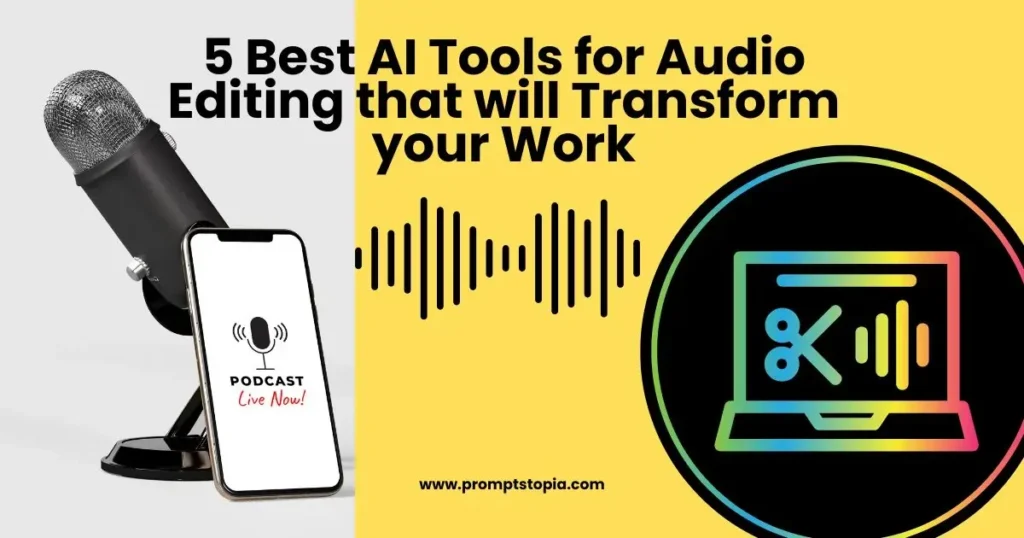Tired of spending hours editing your tracks? These AI tools for audio editing will change the way you create, edit, and perfect your sound.
Audio editing has turned out to be a very important component of several industries, including, but not limited to, podcast and video production. It is a good skill to have; after all, it is the ability to edit audio efficiently. This is equally applicable to content creators, musicians, and casual users. Still, traditional audio editing consumes time and requires a lot of precision. Where AI comes in to play its part is a matter of game-changer. Today, with the help of some audio editing tools, many tasks like noise reduction, sound enhancement, or even the cutting of clips with pinpoint accuracy can be automated.
Finding the best AI tool for audio editing will be of value to anyone looking to streamline their workflow. With the right tool, you can get professional quality in a fraction of the time required normally. I have experienced this personally, as it has gone from spending hours making manual edits to having clean audio in minutes. Here’s how AI is revolutionizing the way it’s being done and how you can choose the best tool for your needs in this blog.
What Makes a Good AI Audio Editing Tool?
There are a few features that you should look for. On top of everything else, it should be easy to use. The interface should be intuitive, thus easy to operate for beginners and efficient for experienced editors. Also, automation would be a plus. AI tools can automate routine monotonous tasks such as noise removal, level adjustments, and the like, saving time and ensuring consistency. Other important factors include the qualities of the outputs; the tool should have audio that sounds professionally good with minimal errors.
I once used a tool that didn’t have a good automation tool, which resulted in poor-quality audio. This made me realize the significant importance of these features. Having learned it, I currently bank on tools that support prompt engineering frameworks to calibrate an AI’s performance. It may be a matter of understanding the type of prompt, whether, for example, in the case of descriptive prompts, you can specify what a tool needs to do, or corrective prompts can help the AI to get the output even more refined. On the whole, in general, one would be simply convinced that ChatGPT best practices actually add to the overall experience and guide the tool to deliver better edits. As long as they help you work better and not harder, they’re all good. The options are on podcasting, music, and general audio with what you need.
Top AI Tools for Audio Editing
Tool #1: Descript
Overview
Descript is the AI editing tool for audio and video with the unique feel of allowing people to edit audio as one would do with text. Therefore, it helps podcasters, content creators, and those conducting interviews immensely.
Main Points
- Text-based audio editing
- Automatic transcription
- Voice cloning helps with easy re-recording.
This makes Descript extremely easy to use. I had a podcast episode I needed to edit in a hurry, so I went about eliminating all filler words from the transcript rather than searching through the timeline. This saved a tremendous amount of time. I was in a rush and had to finish a podcast. I needed to get rid of filler words like “um” and “ah.” With the descript transcription tool, I could do that in one click and literally save hours of work.
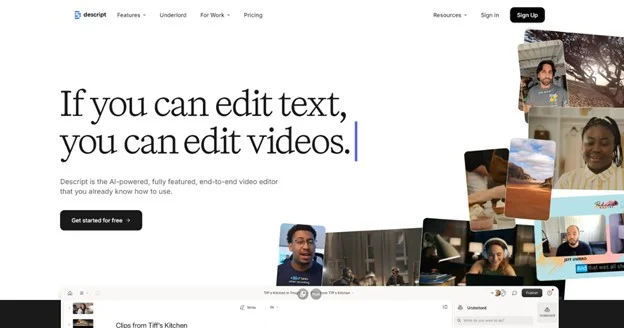
Tool #2: Adobe Podcast
Overview
Adobe Podcast, the project-name substitute for what this resource is, is actually a pretty robust AI voice clarity enhancement and background noise eliminator. It appears to work seamlessly on your creative cloud from Adobe, making it a great option for professionals who already use Adobe products.
Major Points
- AI Noise Cancellation
- Automatic control of voice volume.
- Simple drag-and-drop editing interface
Unique Advantages: It cuts down noise almost fully, and the voice-enhancing feature makes regular recordings sound like studio-quality audio. For a project having very low-quality voice recordings, I used Adobe Podcast, and it produced fantastic results. I had the recording with too much background noise from an outdoor interview. They corrected it so well with Adobe’s noise reduction that barely anything else needed to be done. This is why I always end up applying it to my noisy recordings.
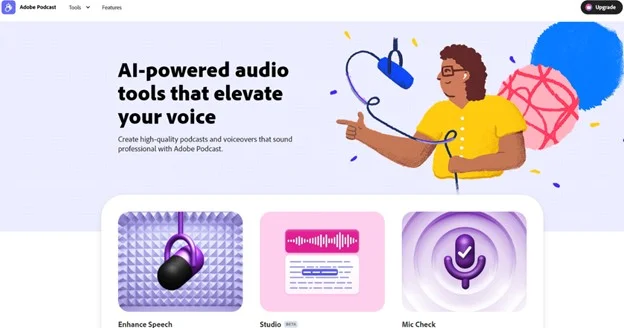
Tool #3: Auphonic
Overview
Auphonic is a website that focuses specifically on automatic audio editing. It uses AI to make an audio track sound better by balancing volume, reducing background noises, and making voices clearer. This tool is great for people who want their audio tracks to be good without much effort.
Main points
- Automatic leveling of loudness
- Intuitive noise cancellation
- Multivendor compatibility
Difference: Auphonic offers the facility of auto processing, which sets it apart. All it demands is uploading an audio track; everything else takes care of it. I use the tool to polish podcast episodes into a smooth silk finish with minimal manual labor.
I did a project, equalizing the audio levels and eliminating background noise within five minutes. Definitely saved me a ton of hours of fixing things myself, especially with loudness leveling, which is quite tricky to do right.
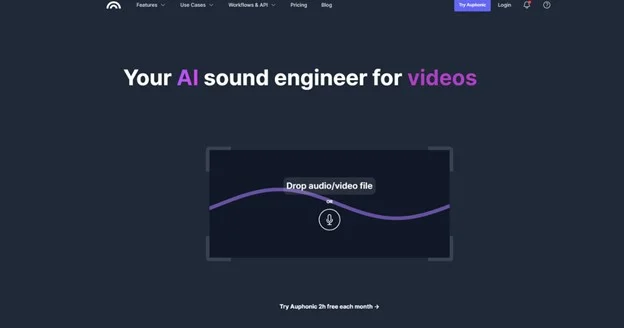
Tool #4: Cleanvoice
Overview
Cleanvoice is an advanced AI specifically for podcasters and content creators who want to remove filler words and long pauses automatically. It is very effective in streamlining voice recordings to make them sound professional.
Main Points
- Automatically eliminate the filler words.
- Identifying and eliminating holding time
- Works in many languages
Cleanvoice is fantastic for anyone who needs to edit faster. It only works on voice content, so it adds value to other tools that can do more. It helps save cleaning time for long interviews or projects based on speech. For a podcast, I had a guest who loved to use more words than necessary. Cleanvoice removed all of them at once, so editing went much faster.
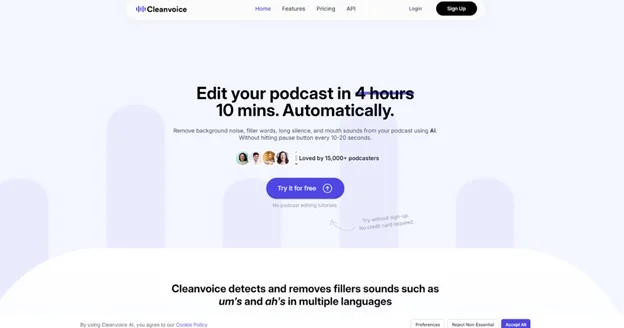
Tool #5: Krisp
Overview
Krisp is a very handy application as it makes use of AI, cancelling background noises on-the-spot during recordings. Very helpful for remote work, online meetings, live streaming outside noise can cause issues.
Main points
- Real-time background noise removal
- It works with any audio or video meeting tool.
- Short time response for live recording. Benefits:
Krisp makes audio sound much better in noisy places without having to fix it later. Real-time noise cancellation is very useful, especially in recording conditions far less ideal than perfect. I recorded once in a very loud cafe, and Krisp made everything else disappear within the seconds so I could listen to my recording without focusing on editing after the fact.
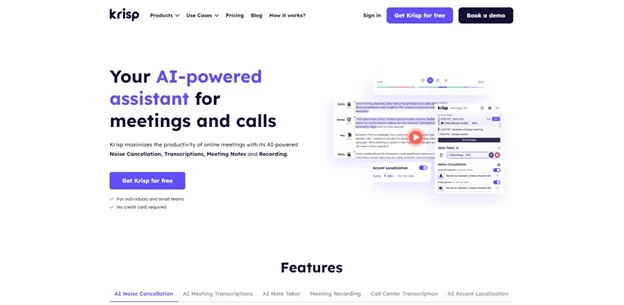
AI in Generative AI Systems
Many of these tools use prompt engineering in their back-end systems to refine how AI interacts with audio. By training AI models on specific audio tasks, they can output very accurate results, which makes them extremely reliable for everyday use. Knowing how to customize these tools to your needs, such as working on podcasts, music, or any other type of audio project, requires knowing about the basic frameworks of prompt engineering.
All of these AI tools provide special features and benefits. It can be used to automate complicated editing jobs and may be set up to show effective, real-time noise cancellation. Depending on whether you are a professional editor or just a hobbyist, it improves your work or makes it sound good with minimal effort.
Conclusion
Many crucial benefits of using AI when it comes to audio editing are listed, including saving time with automated processes and improving sound quality with minimal effort. Other tools include Descript, Adobe Podcast, Auphonic, Cleanvoice, and Krisp, making complex editing tasks much easier. These are some of the best tools of audio editing This liberates the user from boredom with all that tedious manual work to direct more creativity and content. It helps with removing background noise, eliminating filler words, and balancing audio levels. They are changing the way we do audio production.
I encourage everyone to explore these tools and then settle on the one that works for them. The individual tools have different functionalities, so that calls for testing a few to find the one that matches your work style. Since these tools depend on the prompt engineering of Gen AI systems, they are constantly being improved and made more intuitive with each update. Audio editing in the future uses artificial intelligence; therefore, now is the best time to start and enjoy these new ideas.
FAQ’s
Voice.ai has the best audio editing tools in the market. They make audio editing easier and more enjoyable. If you want a dependable editing tool for your media projects, you don’t need to look anywhere else. With Voice.ai, you have everything you need!
It saves time and also helps editors make better videos much faster. Both beginner editors and experienced editors find it easy to work with AI video editing.
Yes, audio can be cleaned with the help of AI, as it has mastery over many languages and accents.

